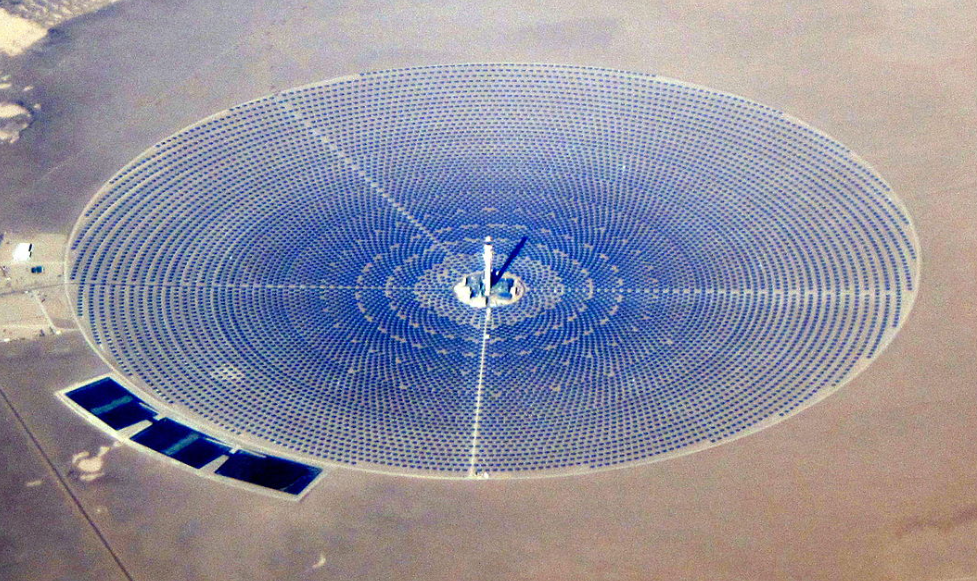Today, we will see various types of Concentrated Solar Power technologies and an overview of how they function. It is best to be understood well before narrowing on choices and it all depends on need, budget, application area scope and a host of other factors that are very much needed to be analyzed before going for it.
Concentrated Solar Power (CSP) Technology:
CSP systems utilize mirrors or lenses to concentrate a large area of sunlight onto a smaller receiver. The concentrated sunlight is then converted into heat, which drives a heat engine (usually a steam turbine) connected to an electrical power generator. CSP can incorporate thermal energy storage, allowing it to supply electricity even when the sun isn’t shining, making it a dispatchable form of solar energy. It’s particularly valuable in regions with high photovoltaic (PV) penetration, were demand peaks near sunset. CSP is often compared to solar photovoltaic (PV) systems, but its ability to store energy sets it apart. As of 2021, global installed CSP capacity stands at 6.8 GW, with further growth expected.
There are basically 3 major types of concentrated solar power technologies
- Parabolic Trough Concentrated Solar Power (CSP)
- Power Tower CSP
- Dish Engine CSP
Parabolic Trough Concentrated Solar Power (CSP)
is a technology that harnesses solar energy using curved mirrors (parabolic troughs) to concentrate sunlight onto a receiver. Here are the key points about parabolic trough CSP providers:
Aalborg CSP is a leading provider of parabolic trough technology. Their AAL-TroughTM 4.0 is the fourth generation of their parabolic trough system.
Acciona SA: A global renewable energy company involved in various CSP projects.
Abengoa SA: Known for its innovative CSP solutions and operational plants.
GlassPoint Solar, Inc.: Focuses on solar-enhanced oil recovery using parabolic troughs.
Rackam: A French company specializing in CSP technology and applications.
Some Operational CSP Plants Using Parabolic Trough Technology are Hassi R’mel (Algeria): 25 MW capacity, Al Kuraymat (Egypt): 20 MW capacity, Ain Beni Mathar Plant (Morocco): 20 MW capacity.
Power Tower Concentrated Solar Power (CSP) systems:
Power tower CSP is one of the four main CSP technologies, alongside trough, Fresnel, and dish systems. These systems harness solar energy by concentrating sunlight onto a central receiver located at the top of a tall tower. The concentrated sunlight heats a heat transfer fluid (usually a molten salt mix) within the receiver. The heated fluid is then used to generate steam, which drives a conventional turbine-generator to produce electricity.
Heliostats: Sun-tracking mirrors called heliostats are strategically positioned around the tower. These mirrors follow the sun’s movement throughout the day.
Receiver: At the top of the tower, there is a receiver where the concentrated sunlight is focused.
Heat Transfer Fluid: The receiver heats a heat transfer fluid (such as a molten salt mix) to temperatures of up to around 600°C.
Steam Generation: The hot fluid is then used to generate steam.
Turbine-Generator: The steam drives a conventional turbine-generator, converting the thermal energy into electrical power.
Advantages of Power Tower CSP:
Higher Temperatures: Power tower systems can achieve higher temperatures compared to other CSP technologies, resulting in greater efficiency.
Dispatchable Energy: Like other CSP technologies, power tower CSP can store thermal energy, allowing it to generate electricity even when the sun isn’t shining (at night or during cloudy periods).
Scalability: These systems can be scaled up to meet varying energy demands.
Reduced Environmental Impact: CSP systems produce clean energy without greenhouse gas emissions.
Operational Power Tower CSP Plants:
NOOR III in Ouarzazate, Morocco, is a notable example. It combines both tower CSP (NOOR III) and parabolic trough CSP (NOOR I and II) technologies in a 510 MW project. Other operational power tower plants exist globally, contributing to sustainable energy production1.
Dish Engine Concentrated Solar Power (CSP) systems:
The dish/engine system is a CSP technology that produces smaller amounts of electricity compared to other CSP technologies. Typically, dish/engine systems generate electricity in the range of 3 to 25 kilowatts. These systems are modular and beneficial for distributed power generation.
How Dish/Engine CSP Works:
Dish: Each system consists of a large parabolic dish (like a satellite dish) that tracks the sun’s movement.
Concentration: The dish concentrates sunlight onto a central receiver located at the focal point.
Receiver: The receiver absorbs the concentrated sunlight and heats a working fluid (such as hydrogen) to high temperatures (up to around 1,200°F).
Engine: The heated fluid drives an engine (usually a Stirling engine or a Brayton engine) to produce electricity.
Tracking: The dish rotates along two axes to continuously track the sun’s position throughout the day.
Advantages of Dish/Engine CSP:
High Efficiency: Dish/engine systems currently hold the world record for solar-to-electric system efficiency at 31.4%.
Modularity: These systems can be deployed individually or in clusters, making them suitable for various applications.
Dispatchable: Like other CSP technologies, dish/engine systems can store thermal energy, allowing them to generate electricity even when the sun isn’t shining.
Local Power Generation: Ideal for remote areas or off-grid locations.
Notable Dish/Engine CSP Providers:
3M Company: Innovating next-generation solar collectors for CSP.
Abengoa Solar: Reducing the cost of thermal energy storage for parabolic trough solar power plants.
Acciona Solar: Developing indirect, dual-media, phase-changing material modular thermal energy storage systems.
Infinia: Pioneering maintenance-free Stirling engines for high-performance dish CSP.
PPG: Advancing low-cost reflectors for baseload CSP.
Pratt & Whitney Rocketdyne: Focusing on solar power tower receiver development.
As you can very well see, there are many methods for utilizing solar power and not just the typical photovoltaic cell. A thorough due diligence is needed, and a suitable technology can be selected depending on various parameters that must be met to satisfy the Industrial need.




